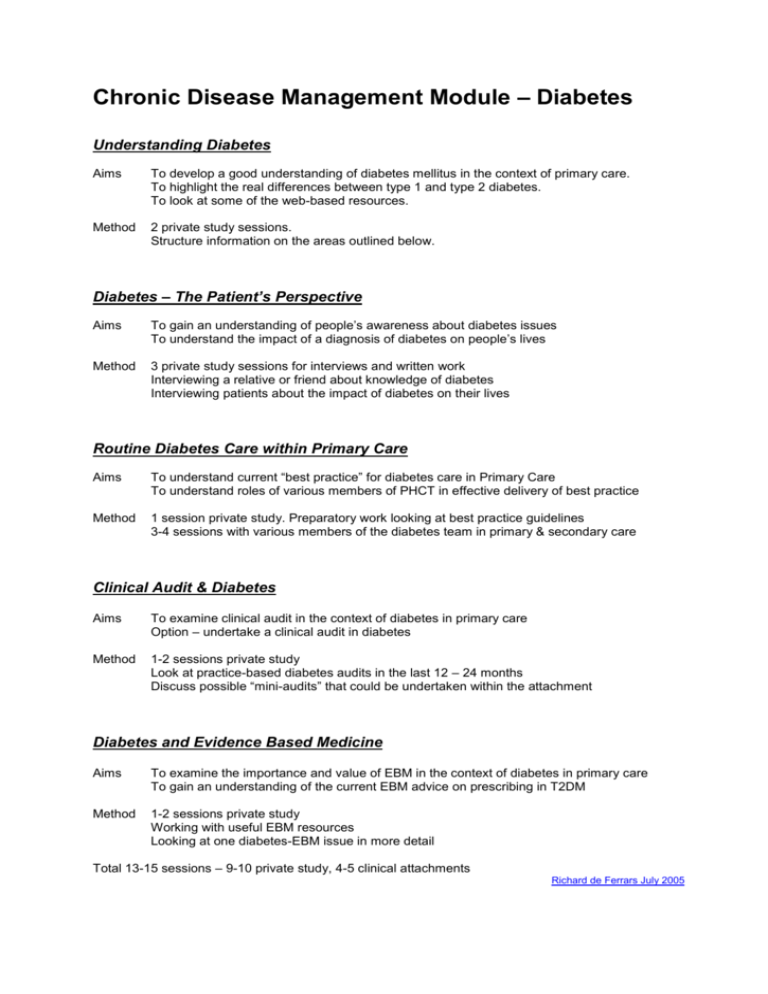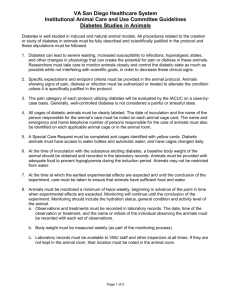Chronic Disease Management Workbook – Diabetes
advertisement

Chronic Disease Management Module – Diabetes Understanding Diabetes Aims To develop a good understanding of diabetes mellitus in the context of primary care. To highlight the real differences between type 1 and type 2 diabetes. To look at some of the web-based resources. Method 2 private study sessions. Structure information on the areas outlined below. Diabetes – The Patient’s Perspective Aims To gain an understanding of people’s awareness about diabetes issues To understand the impact of a diagnosis of diabetes on people’s lives Method 3 private study sessions for interviews and written work Interviewing a relative or friend about knowledge of diabetes Interviewing patients about the impact of diabetes on their lives Routine Diabetes Care within Primary Care Aims To understand current “best practice” for diabetes care in Primary Care To understand roles of various members of PHCT in effective delivery of best practice Method 1 session private study. Preparatory work looking at best practice guidelines 3-4 sessions with various members of the diabetes team in primary & secondary care Clinical Audit & Diabetes Aims To examine clinical audit in the context of diabetes in primary care Option – undertake a clinical audit in diabetes Method 1-2 sessions private study Look at practice-based diabetes audits in the last 12 – 24 months Discuss possible “mini-audits” that could be undertaken within the attachment Diabetes and Evidence Based Medicine Aims To examine the importance and value of EBM in the context of diabetes in primary care To gain an understanding of the current EBM advice on prescribing in T2DM Method 1-2 sessions private study Working with useful EBM resources Looking at one diabetes-EBM issue in more detail Total 13-15 sessions – 9-10 private study, 4-5 clinical attachments Richard de Ferrars July 2005 Understanding Diabetes Aims To develop a good understanding of diabetes mellitus in the context of primary care. To highlight the real differences between type 1 and type 2 diabetes. To look at some of the web-based resources. Method 2 private study sessions. Structure information on the areas outlined below. Resources Diabetes National Service Framework (www.dh.gov.uk A-Z Index) NeLH (www.nelh.nhs.uk) Diabetes UK (www.diabetes.org.uk) Good document – “Diabetes mellitus – an update for healthcare professionals” www.bma.org.uk/ap.nsf/Content/Diabetes/$file/diabetes.pdf 1. Find and read “The St Vincent Declaration” on diabetes – 15 years on, how well are we doing? 2. Highlight the differences between type 1 and 2 under the following headings Definitions Type 1 & type 2 Other types (including impaired glucose regulation) Blood glucose values used in the definitions Aetiology What goes wrong in type 1 diabetes? What goes wrong in type 2 diabetes, especially role of metabolic syndrome & insulin resistance? Epidemiology Problems with rising levels of obesity. Look for prevalence estimates – past and future Morbidity and mortality from diabetes Microvascular and macrovascular disease Key complications with type 1 diabetes Key complications with type 2 diabetes Treatment of diabetes What are the major issues & treatment targets for the following areas: Lifestyle issues Drug treatments – BP, lipids, glucose, CV disease Diabetes in the young Diabetes in pregnancy NB – keep this simple. EBM and use of ACE, statins etc is looked at in more detail later Services available: Which healthcare professionals are in the “diabetes team”? What role do they have in diabetes care Primary care & Community Secondary Care GP’s Doctors – medical, surgical Nurses Specialist nurses Podiatrists Dietitians Opticians Diabetes – The Patient’s Perspective Aims To gain an understanding of people’s awareness about diabetes issues To understand the impact of a diagnosis of diabetes on people’s lives Method 3 private study sessions for interviews and written work Interviewing a relative or friend about their knowledge of diabetes Interviewing patients about the impact of diabetes on their lives 1. Interview a friend or relative about diabetes Choose a willing volunteer! – a friend or relative with young children to discuss type 1 DM an older relative (eg parent) to discuss type 2 DM They must not be a medic!! They / their child has just been to see their GP and been told that they have diabetes. Speak to them for 20- 30 minutes, discussing these issues: What is their prior knowledge of diabetes? What are their immediate fears? What are their longer term concerns about their health? What would they want to know in the next few days and weeks? Write a brief summary of the discussion How do their answers compare to what you expected? How well does information offered to a new diabetic at the surgery meet their concerns? Look at Diabetes UK website (www.diabetes.org.uk) from the perspective of a newly diagnosed diabetic 2. Interview a patient with diabetes Select a suitable patient through discussion with your clinical supervisor Speak to them for 20- 30 minutes, discussing these issues: What impact has the diagnosis of diabetes had on their life? What changes have they needed to make to their life / lifestyle? What problems have they had related to the diabetes? What are their major health concerns in the next few years? Where have they found information and support about diabetes? Write a brief summary of the discussion Routine Diabetes Care within Primary Care Aims To understand current “best practice” for diabetes care in Primary Care To understand roles of various members of PHCT in effective delivery of best practice Method 1 session private study. Preparatory work looking at best practice guidelines 3-4 sessions with various members of the diabetes team in primary & secondary care Resources National Service Framework for diabetes (www.dh.gov.uk) – mainly Standard 4 Diabetes UK web-site (www.diabetes.org.uk) – “What Diabetes Care to Expect” NICE Guidance (www.nice.org.uk) - guidance on feet, eyes, BP, lipids……. New GMS contract – Diabetes Quality Outcomes Framework What is current “best practice?” Browse the on-line resources and draw up a picture of what you believe reflects current best practice for care of patients with diabetes. This exercise is concentrating on routine care of identified diabetics, so do not look at issues like prevention, screening and early detection. Try and build a picture of what care the patients should receive – who they should see, what tests should be taking place, what examinations should be taking place….. You should aim to identify best practice in 2 areas 1. Immediate advice, treatment and follow up for a patient with newly identified diabetes 2. Standard care, particularly at “annual review” Having identified “best practice”, within the “diabetes team”, who is best placed to deliver each aspect of best practice What systems are in place within the surgery for the following groups? Care of new diabetics Routine reviews Nurse diabetic clinics Delivering “best practice” Attend any diabetic clinics within the surgery Nurse clinics (2 sessions) GP clinics / reviews Compare the service that is offered with your model of best practice Is there duplication of effort? Are there aspects of care that might be delivered better by another member of the team? Are there areas of “best practice” that have yet to be adopted? Roles of other “Diabetes Team” members Hospital diabetic clinic Diabetes Nurse Specialists Opticians Podiatrists Dietitians Arrange one session at a hospital diabetic clinic. Look at the role of these other team members. Discuss with Clinical Supervisor about opportunities for looking at the role of other team members, for instance podiatrists and opticians Clinical Audit & Diabetes Aims To examine clinical audit in the context of diabetes in primary care Option – undertake a clinical audit in diabetes Method 1-2 sessions private study Look at practice-based diabetes audits in the last 12 – 24 months Discuss possible “mini-audits” that could be undertaken within the attachment Introduction “Clinical audit involves systematically looking at the procedures used for diagnosis, care and treatment, examining how associated resources are used and investigating the effect care has on the outcome and quality of life for the patient” (Department of Health, 1993). You should have a basic understanding of the concept of clinical audit, as part of a clinical governance framework. If not – go no further and talk to your educational supervisor! Audit can be a big turn-off and the less relevance that an audit has to your own work, the less interesting it will be! You should complete one audit during the F2 year and diabetes in primary care provides ample opportunity. The more of the work that you complete, the more relevant and useful the exercise will be. QoF Audits A large slice GP pay comes from achieving clinical care targets for various long-term diseases. Diabetes features heavily and this makes it one of the most heavily audited areas in primary care. Obtain a list of the targets for QoF and look at the diabetes. How does this list compare with the “best practice” picture that you looked at? What are the current practice achievement levels - are they higher or lower than you expected? Talk to the lead-doctor for diabetes. What progress has been achieved in the last 3-5 years? Other Diabetic Audits The QoF system (plus the related audits) clearly should help improve delivery of many of the “best practice” objectives. If the practice is currently focussing on one area here, there may be an opportunity to get involved, but generally there will be little “potential for change” and probably little point in doing an audit that is identical to one of the QoF audits. If diabetes is an area that interests you, discuss with your supervisor whether there are opportunities to run an audit looking at some aspect of diabetes. Completing a cycle is hard in a four month attachment, so be careful about picking a complicated area or dealing with more than 15-20 patients. Ideas for audit topics: New diabetics In the past 3 months, how many patients who are not known diabetics had a BSL > 7.1 Look at new diabetics diagnosed in the last 3 months – was the diagnosis made according to recommendations, were any diagnoses made in hospital? Screening for diabetics How many patients with a BMI over 35 (or 40) have had a FBSL (in the last 1-2 years)? What percentage of IHD patients have had a FBSL (in the last 1-2 years)? Diabetes and Evidence Based Medicine Aims To examine the importance and value of EBM in the context of diabetes in primary care To gain an understanding of the current EBM advice on prescribing in T2DM Method 1-2 sessions private study Working with useful EBM resources Looking at one diabetes-EBM issue in more detail Resources Cochrane Library BMJ Clinical Evidence Prodigy NICE guidelines SIGN guidelines www.cochrane.org/index0.htm www.clinicalevidence.com/ www.prodigy.nhs.uk/ www.nice.org.uk/ www.sign.ac.uk/ We are all being encouraged to be more aware of the evidence-base behind the interventions that we make with patient care. There are several aspects to this, but the two most important ones are: 1) Knowing where to find good quality reviews of current EBM 2) Knowing who to look further at a topic and examine the evidence for yourself From you current level of understanding, answer “Yes / No” to the following questions: 1. Should all diabetics take low dose Aspirin? 2. Should all diabetics take a statin? 3. Should all diabetics take an ACE inhibitor? Spend a session examining the listed EBM websites and glean the current view on these topics. You should pick one to look at in-depth and if time allows, look at the others also. Some websites are easier to use than others and you should make a note of which you prefer. You may come across references to original papers and review articles – where possible, look at some of these as well. You may need “Athens Registration” to access some journals – this can be arranged through the library at the Post-Graduate Centre. Have your answers to the questions changed? What additional information have you found? 1. Should all diabetics take low dose Aspirin? 2. Should all diabetics take a statin? 3. Should all diabetics take an ACE inhibitor?






